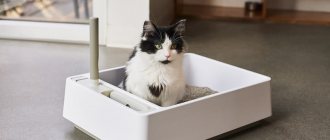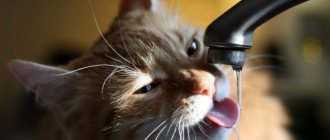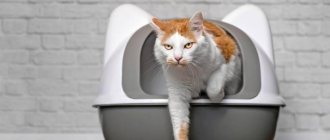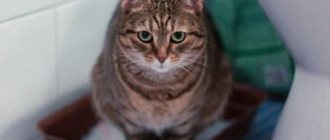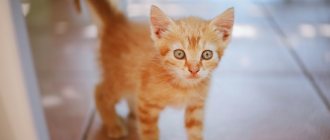Caring owners should know how often the cat goes to the toilet.
These indicators will help identify the disease at an early stage. Disturbances in defecation and urination may indicate the development of the disease. Therefore, any significant deviations from the norm are a reason to show your pet to a veterinarian.
The primary cause may be improper feeding and, as a result, disruption of the digestive system. In this case, it is enough to adjust the animal’s diet and establish the correct food intake.
Frequency of urination in cats
The daily urine volume can range from 50 to 200 ml. The frequency of urination and the amount of fluid released depends on the age, gender, and size of the animal. And also on feeding and the volume of fluid consumed.
For example, kittens can visit the litter box up to 10 times a day. This is due to the small volume of the bladder and is the norm for babies. With age, the number of visits decreases to five times a day.
Due to the physiological characteristics of the body, cats visit the litter box more often than cats. The norm for urination for an adult cat is 5–6 times. The frequency of trips to the toilet does not depend on whether the cat is neutered or not.
Adult cats go to the litter box about 3 times a day. The number of visits to the tray may increase during pregnancy and nursing. Also, the number of trips may increase when drinking large amounts of liquid, for example, in the heat or after eating dry food. If there are no natural reasons for frequent urination, then you should consult a veterinarian.
If your cat visits the litter box less than twice a day, you should immediately contact a veterinary clinic. Retention and decrease in urine volume can be symptoms of the development of pathologies in the animal’s body.
Prevention
The incidence of urolithiasis in cats is five times higher than in cats. This disease is one of the most frequently diagnosed after helminthic infestations.
Proper metabolism prevents the formation of stones, so a balanced diet is the key to health, especially when it comes to castrated and sterilized cats. These are truisms, but owners, even when buying premium food, do not comply with the feeding standards indicated on each package, so they mix the finished product with natural food.
Lack of water is one of the reasons for the formation of urate stones, and since cats have a poorly developed sense of thirst, there is a good way to teach your pet to drink more. Place several different vessels with water in different places in the house, this invariably arouses interest in the animals and a desire to try.
Protect your cat from hypothermia. Don't let him sit on a freshly washed floor until it's dry, and don't let him sleep on the floor under an open window. And, of course, watch how often the cat pees. This is the most important marker in home diagnostics of a pet’s health condition.
How often should kittens go to the litter box?
The frequency of bowel movements depends on the feeding regimen and the age of the pet. For example, kittens from 20 days old, with a partial transition to solid food, go to the toilet approximately five times a day. As kittens grow older, they are switched to adult food and by the age of three months, kittens generally walk no more than 4 times a day. From about 6 months, the norm is to visit the litter box once or twice a day.
When introducing new food products into a kitten's diet, short-term disturbances in intestinal function are almost inevitable. Diarrhea or constipation during the day is not a cause for concern. If the kitten’s general condition is stable, then a visit to the veterinary clinic is not required.
How much urine should be produced during pregnancy?
Consultation with a hepatologist and gastroenterologist
Go to online consultation:
1).
consultation with a hepatologist-gastroenterologist
;
2). consultation with a gynecologist
;
3). consultation with a urologist
;
4). pediatrician
consultation ;
5). consultation with a dermatologist
;
6). consultation with a narcologist
;
7). consultation with an otolaryngologist
;
8). surgeon
consultation ;
9). consultation with a proctologist
Good afternoon, what color should pregnant women’s urine be? If it is yellow and cloudy, is this normal? I take vitamins Prental Vitrum.
Hello. Yellow urine is normal, but cloudy urine is not so much. When was the last time you had a urine test? What is the gestational age?
Inflammation of the genitourinary system - cystitis, pyelonephritis, urinary diathesis. Pregnant women have a lot of stress on their kidneys, there is no need to take risks, it is better to be safe. And it’s time to register, when do you plan?
My kidneys don’t really hurt, but sometimes my lower back hurts. I go a little often. When I go. does not hurt. But before pregnancy I was diagnosed with chronic cystitis. Which I treated (like orgil) and planned a pregnancy after I drank it. (The doctor said so) I plan to register in 3-4 weeks.
Hello. I’m worried. A month ago, things went well for me twice, the second time it somehow hurt and I was craving something salty or sour, now only the smells irritate me and I felt sick three weeks ago, now the delay is a week, even more. and the urine was cloudy, I wanted to do a test, I bought it, but it wasn’t there, but that’s not the main thing..what can you say?
delay 3rd day, positive test. Urine was cloudy for 2 days, passed a general urine test - reaction ph8, specific weight 1.015. a week ago I took 4 tablets. furadonina-kidney was sick (I didn’t suspect pregnancy yet). Are these bad indicators? Do they indicate poor kidney function?
Source
How often do adult cats go to the litter box?
Adult cats visit the litter box much less often than young animals. Some pets are limited to 1 bowel movement per day.
There are cats that go to the litter box once every two days. This is not associated with pathological changes, but is an individual feature of the animal. A health hazard may arise if a cat does not go to the toilet for more than 4 days.
The frequency of bowel movements depends not only on the age, but also on the character of the pet. Some cats may intentionally leave small odorous piles in unexpected places throughout the day. The reasons may be a change in diet, stress, rough treatment of the pet, a new pet and other factors.
In this case, the cat's health is not in danger. This behavior can be corrected by identifying and eliminating the causes of anxiety and irritation. And also achieve mutual understanding with your pet.
Another reason for improper functioning of the gastrointestinal tract may be an unbalanced diet. If there is a high content of protein or fiber in the animal’s body, a malfunction occurs. Indigestion can be eliminated by adjusting your diet.
Elderly cats
As pets age, changes occur in their bodies that affect the frequency of trips to the toilet. In older animals, defecation may occur once every two days. The color and consistency of stool also changes. Unformed or too hard stool is normal.
It is important to monitor your pet's overall health. If the animal feels well and exhibits normal activity, then you should not consult a doctor. But if the cat moans during bowel movements or sits on the tray for a long time, then it is better to seek advice from a specialist.
Treatment of diseases of the urinary system
Self-treatment of your pet is unacceptable. The only thing the owner can do to help his cat is to show him to a veterinarian so that he can determine the cause of the painful condition, find out why the animal cannot pee, and prescribe adequate treatment.
Regardless of the reason why a cat does not pee, the first step of therapy should be aimed at restoring the flow of urine and eliminating pain in the animal. Common diseases of the urinary system and features of their treatment:
- Urolithiasis disease. Pathology occurs due to the formation of stones in the bladder. An animal can sit in a tray for a long time, but still not go to bed. If a small amount of sand or small stones is detected, conservative therapy is carried out. The animal is prescribed anti-inflammatory and painkillers, IV drips and diet. If the urinary tract is blocked, catheterization or surgery is required - urethrostomy, when a new opening is formed for urine output.
- Cystitis. Bladder inflammation requires immediate specialist intervention. The pathological process can be quickly stopped with the help of antispasmodic, antibacterial, diuretic and hemostatic drugs (if there is blood in the urine). Advanced cystitis becomes chronic and periodically torments the pet with severe attacks. Treatment of cystitis should also include therapy for the disease that provoked the pathological process - urolithiasis, urethritis, diabetes mellitus, etc.
- Urethritis. Inflammation of the urethra is mainly diagnosed in castrated cats. The risk of developing an inflammatory process is increased by urolithiasis of the kidneys and bladder, nephritis, urethral injuries, etc. Therapy for inflammation includes antiseptic treatment of the pet’s urethra, the use of painkillers, antihistamines and diuretics. In severe cases, the urethra is washed with a solution of silver ions.
- Atony of the bladder. Weakening of the walls of the organ may be associated with poor nutrition, the presence of stones and inflammation in the genitourinary system, spinal injury, age of the pet, etc. In this case, the animal not only urinates little, but may also involuntarily urinate in its sleep. With anuria, there is a high risk of bladder rupture, so you need to install a catheter in your pet as soon as possible to remove urine. Next, conservative treatment is carried out using antibacterial, anti-inflammatory and drugs that stimulate the tone of the bladder walls.
Impaired formation of feces
Short-term diarrhea may be caused by changes in feeding composition, stress or overeating. If you have one-time loose stools, you do not need to go to the clinic. But if diarrhea continues for several days, then you should contact a specialist.
Main causes of diarrhea:
A sudden change in diet. New feeds and individual components should be introduced gradually.- Inappropriate feed composition. Sometimes pets, due to the characteristics of their bodies, do not digest certain foods well. The problem can be solved by reviewing and adjusting the diet.
- Poor quality feed.
- Metabolic disease.
- Worm infestation. Toxins and waste products of worms lead to poisoning of the animal’s body.
Diarrhea can also be caused by neoplasms, infections, bacteria, peptic ulcers and other pathologies. To make an accurate diagnosis, you should contact a veterinary clinic. The doctor will conduct an examination and prescribe appropriate tests.
Causes of constipation:
- Excess protein in the diet.
- Dehydration of the body. Usually develops when feeding dry food without free access to water.
- Obstruction or blockage of the intestine. For example, bloat, tumor, hairballs or worms.
- Decreased activity.
- Constant or severe stress.
Before diagnosis, the animal should not be given laxatives. Increased intestinal motility due to blockage can lead to the death of the pet. If constipation persists for 2–3 days, you should consult a veterinarian.
What should be done in case of deviations from the norm?
Prolonged violation of the litter tray requires urgent contact with a veterinarian. First of all, it is necessary to establish the cause, and then carry out treatment.
Most deviations from the norm can be treated by adjusting the diet. But some diseases require urgent intervention and long-term therapy.
Diagnostics
An experienced veterinarian can make a preliminary diagnosis simply by examining the pet and talking with the owners. He will definitely ask how often the cat pees. However, in most cases, one or more diagnostic measures are required:
- urinalysis is an important study that allows you to detect changes in the pH and density of urine, sand, salts, protein, glucose;
- biochemical blood test is a highly informative diagnostic method that determines the condition of internal organs and systems;
- Ultrasound of the abdominal organs is now practiced in most veterinary clinics for the timely detection of infectious, inflammatory and tumor diseases.
Based on the diagnostic results, the doctor prescribes treatment. It is necessary to fight for the animal, especially since modern veterinary medicine has all the necessary means for treatment.
When should you contact a veterinarian?
Having noticed that the cat has begun to rarely visit the litter box, it is necessary to observe whether other symptoms have appeared. If they are there, you can’t hesitate. Atypical behavior when urinating - a strange posture, meowing - should alert you.
Pathology is indicated by weakness, lethargy and apathy, excessive appetite or refusal to eat, and weight loss. Other reasons to contact a veterinarian:
- indigestion (vomiting, diarrhea or constipation);
- increased or decreased body temperature;
- pallor of the mucous membranes;
- uncharacteristic impurities in the urine (pus, blood);
- strong unpleasant odor of urine.
Some diseases have subtle symptoms, so if the deviation in the number of urination acts persists for more than 3 days, you should show your pet to a doctor. Under no circumstances should you self-medicate; this can aggravate the situation and lead to dangerous complications.
